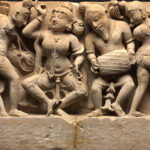The Abhinavabharati Is Completed
1000–1050 CE
The earliest known bhasya (commentary) on the Natyashastra is composed by the aesthetician Abhinavagupta, in the Kashmir valley. The Abhinavabharati expounds on rasa theory, which describes the nature of aesthetic experience and provides a summary of previous debates around rasa, thus contributing significantly to modern interpretive frameworks of the Natyashastra.
Abhinavagupta’s aesthetics are examples of a much wider world of aesthetic enquiry in the medieval period, with others such as the Paramara king Bhoja of Dhara writing important treatises. Abhinavagupta’s work is, however, among the most influential.
Bibliography
Ganser, Elisa. Theatre and Its Other: Abhinavagupta on Dance and Dramatic Acting. Leiden: Brill, 2022.
Mukherji, Parul Dave. “Who Is Afraid of Mimesis? Contesting the Common Sense of Indian Aesthetics Through the Theory of ‘Mimesis’ or Anukaraṇa Vada.” In The Bloomsbury Research Handbook of Indian Aesthetics and the Philosophy of Art, edited by Arindam Chakrabarti. Bloomsbury Academic, 2016.
Pandey, Kanti Charan. Abhinavagupta: An Historical and Philosophical Study. 2nd ed. Vol. 1. Varanasi: Chowkamba Series Office, 1963.
Pollock, Sheldon. A Rasa Reader: Classical Indian Aesthetics. New York: Columbia University Press, 2016.
Feedback 
This entry appears in
Art in South Asia
Visit Timeline
Associated Timeline Events
First Published: March 11, 2024
Last Updated: May 21, 2024





